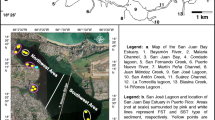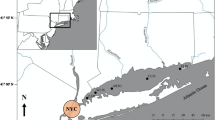Abstract
The effect of varying salinity on phenanthrene and glutamate mineralization was examined in sediments along a natural salinity gradient in an urban tidal river. Mineralization was measured by trapping14CO2 from sediment slurries dosed with trace levels of [14C]phenanthrene or [14C]glutamate. Sediments from three sites representing three salinity regimes (0, 15, and 30%.) were mixed with filtered column water from each site. Ambient phenanthrene concentrations were also determined to calculate phenanthrene mineralization rates. Rates of phenanthrene mineralization related significantly to increasing salinity along the transect as determined by linear regression analysis. Rates ranged from 1 ng/hour/g dry sediment at the freshwater site to > 16 ng/hour/g dry sediment at the 30‰ salinity site. Glutamate mineralization also increased from the freshwater to the marine site; however, the relationship to salinity was not statistically significant.
To examine the effect of salinity on mineralizing activities, individual sediments were mixed with filtered water of the other two sites. Slurries were also made with artificial seawater composed of 0, 15, or 30 g NaCl/ liter to substitute for overlying water. Rates of phenanthrene mineralization in the 0‰ ambient salinity sediments were not affected by higher salinity waters. Activities in the 15 and 30‰ ambient salinity sediments, however, were significantly inhibited by incubation with 0‰ salinity water. The inhibition, in large part, appears to be due to the decreased NaCl concentration of the water phase. Glutamate mineralization was affected in a similar manner, but not as dramatically as phenanthrene mineralization. The results suggest that phenanthrene degraders in low salinity estuarine sediments subject to salt water intrusion are tolerant to a wide range of salinities but phenanthrene degradation in brackish waters is mainly a function of obligate marine microorganisms.
Similar content being viewed by others
References
Atlas RM (1981) Microbial degradation of petroleum hydrocarbons: An environmental perspective. Microbiol Rev 45:180–209
Baker JM (ed) (1976) Marine ecology and oil pollution. John Wiley and Sons, New York
Bartholomew GW, Pfaender FK (1983) Influence of spatial and temporal variations on organic pollutant biodegradation rates in an estuarine environment. Appl Environ Microbiol 45:103–109
Bauer JE, Capone DG (1985) Degradation and mineralization of the polycyclic aromatic hydrocarbons anthracene and naphthalene in intertidal marine sediments. Appl Environ Microbiol 50:81–90
Bauer JE, Capone DG (1988) Effects of co-occurring aromatic hydrocarbons of degradation of individual polycyclic aromatic hydrocarbons in marine sediment slurries. Appl Environ Microbiol 54:1649–1655
Bauer JE, Kerr RP, Bautista MF, Decker CJ, Capone DG (1988) Stimulation of microbial activities and polycyclic aromatic hydrocarbon degradation in marine sediments inhabited byCapitella capitata. Mar Environ Res 25:63–84
Bender ME, Hargis WJ, Huggett RJ, Roberts MH (1988) Effects of polynuclear aromatic hydrocarbons of fishes and shellfish: An overview of research in Virginia. Mar Environ Res 24:237–241
Bourquin AW, Przybyszewski VA (1977) Distribution of bacteria with nitrilotriacetate-degrading potential in an estuarine environment. Appl Environ Microbiol 34:411–418
Cerniglia CE (1984) Microbial transformation of aromatic hydrocarbons. In: Atlas RM (ed) Petroleum microbiology. MacMillan, New York, pp 99–128
Colwell RR (ed) (1984) Vibrios in the environment. John Wiley and Sons, New York
DeLaune RD, Patrick WH, Casselman ME (1981) Effect of sediment pH and redox conditions on degradation of benzo(a)pyrene. Mar Pollut Bull 12:251–253
Garcia-Valdes E, Cosar E, Rotger R, Lalucat J, Ursing J (1988) New naphthalene-degrading marinePseudomonas strains. Appl Environ Microbiol 54:2478–2485
Gardner WS, Lee RF, Tenore KR, Smith LW (1979) Degradation of selected polycyclic aromatic hydrocarbons in coastal sediments: Importance of microbes and polychaete worms. Water Air Soil Pollut 11:339–347
Gibson DT (1968) Microbial degradation of aromatic compounds. Science 161:1093–1097
Guerin WF, Jones GE (1988) Mineralization of phenanthrene by aMycobacterium sp. Appl Environ Microbiol 54:937–944
Hambrick GA, DeLaune RD, Patrick WH (1980) Effect of estuarine sediment pH and oxidation-reduction potential on microbial hydrocarbon degradation. Appl Environ Microbiol 40:365–369
Heitkamp MA, Cerniglia CE (1987) Effects of chemical structure and exposure on the microbial degradation of polycyclic aromatic hydrocarbons in freshwater and estuarine ecosystems. Environ Toxicol Chem 6:535–546
Heitkamp MA, Freeman JP, Cerniglia CE (1987) Naphthalene biodegradation in environmental microcosms: Estimates of degradation rates and characterization of metabolites. Appl Environ Microbiol 53:129–136
Herbes SE, Schwall LR (1978) Microbial transformation of polycyclic aromatic hydrocarbons in pristine and petroleum-contaminated sediments. Appl Environ Microbiol 35:306–316
Hites RA, Biemann K (1972) Water pollution: Organic compounds in the Charles River, Boston. Science 178:158–160
Hites RA, LaFlammme RE, Farrington JW (1977) Polycyclic aromatic hydrocarbons in recent sediments: The historical record. Science 198:829–831
Kerr RP, Capone DG (in press) The effect of salinity on the microbial mineralization of two polycyclic aromatic hydrocarbons in estuarine sediments. Mar Environ Res
Kiyohara H, Nagao K (1978) The catabolism of phenanthrene and naphthalene by bacteria. J Gen Microbiol 105:69–75
Krieg NR, Holt JG (eds) (1984) Bergey's manual of systematic bacteriology, vol 1. Williams and Wilkins, Baltimore
Lee RF, Ryan C (1976) Biodegradation of petroleum hydrocarbons by marine microbes. In: Sharpley JM, Kaplan AM (eds) Proc 3rd Int Biodegradation Symposium. Applied Science Publishers, London, pp 119–125
Leversee GJ, Giesy JP, Landrum PF, Gerould S, Bowling JW, Fanwin TE, Haddock JD, Bartell SM (1982) Kinetics and biotransformation of benzo(a)pyrene inChironomus riparius. Arch Environ Contam Toxicol 11:25–32
Levinton JS (1982) Marine ecology. Prentice-Hall, Inc, Englewood Cliffs, New Jersey
May WE (1980) The solubility behavior of polycyclic aromatic hydrocarbons in aqueous systems. In: Petrakis L, Weiss FT (eds) Petroleum in the marine environment, American Chemical Society, Washington DC
McElroy AE (1985)In vivo metabolism of benz(a)anthracene by the polychaeteNereis virens. Mar Environ Res 17:133–136
McElroy AE, Farrington JW, Teal JM (1989) Metabolism of polynuclear aromatic hydrocarbons in the aquatic environment. In: Varanasi U (ed) Metabolism of polynuclear aromatic hydrocarbons in the aquatic environment. CRC Press, Boca Raton, pp 1–39
Means JC, Hasett JJ, Wood SG, Banwart WL (1980) Sorption properties of polynuclear aromatic hydrocarbons by sediments and soils. Environ Sci Technol 14:1524–1528
Pfaender FK, Shimp RJ, Larson RJ (1985) Adaptation of estuarine ecosystems to the biodegradation of nitrilotriacetic acid: Effects of preexposure. Environ Toxicol Chem 4:587–593
Pipe RK, Moore MN (1986) An ultrastructural study on the effects of phenanthrene on lysosomal membranes and distribution of the lysosomal enzymeβ-glucuronidase in digestive cells of the periwinkleLittorina littorea. Aquat Toxicol 8:65–76
Readman JW, Mantoura RFC, Rhead MM, Brown L (1982) Aquatic distribution and heterotrophic degradation of polycyclic aromatic hydrocarbons (PAH) in the Tamar Estuary. Estuar Coast Shelf Sci 14:369–389
Sayler GS, Perkins RE, Sherrill TW, Perkins BK, Reid MC, Shields MS, Kong HL, Davis JW (1983) Microcosm and experimental pond evaluation of microbial community response to synthetic oil contamination in freshwater sediments. Appl Environ Microbiol 46:211–219
Shiaris MP (1989) Seasonal biotransformation of naphthalene, phenanthrene, and benzo[a]pyrene in surficial estuarine sediments. Appl Environ Microbiol 55:1391–1399
Shiaris MP, Cooney JJ (1983) Replica plating method for estimating phenanthrene-utilizing and phenanthrene-cometabolizing microorganisms. Appl Environ Microbiol 45:706–710
Shiaris MP, Jambard-Sweet D (1986) Polycyclic aromatic hydrocarbons in surficial sediments of Boston Harbour, Massachusetts, USA. Mar Pollut Bull 17:469–472
Sisler FD, Zobell CE (1947) Microbial utilization of carcinogenic hydrocarbons. Science 106:521–522
Spain JC, Pritchard PH, Bourquin AW (1980) Effects of adaptation on biodegradation rates in sediment/water cores from estuarine and freshwater environments. Appl Environ Microbiol 40:726–734
Spain JC, Van Veld PA (1983) Adaptation of natural microbial communities to degradation of xenobiotic compounds: Effects of concentration, exposure time, inoculum, and chemical structure. Appl Environ Microbiol 45:428–435
Varanasi U, Reichert WL, Stein JE, Brown DW, Sanborn HR (1985) Bioavailability and biotransformation of aromatic hydrocarbons in benthic organisms exposed to sediment from an urban estuary. Environ Sci Technol 19:836–841
Ward DM, Brock TD (1978) Hydrocarbon biodegradation in hypersaline environments. Appl Environ Microbiol 35:353–359
West PA, Okpokwasili GC, Brayton PR, Grimes DJ, Colwell RR (1984) Numerical taxonomy of phenanthrene-degrading bacteria isolated from the Chesapeake Bay. Appl Environ Microbiol 48:988–993
Wijayaratne RD, Means JC (1984) Sorption of polycyclic aromatic hydrocarbons by natural estuarine colloids. Mar Environ Res 11:77–89
Wolfe DE (ed) (1977) Fates and effects of petroleum hydrocarbons in marine organisms and ecosystems. Pergamon Press, New York
Youngblood MW, Blumer M (1975) Polycyclic aromatic hydrocarbons in the environment: Homologous series in soils and recent marine sediments. Geochim Cosmochim Acta 39:1303–1314
Author information
Authors and Affiliations
Rights and permissions
About this article
Cite this article
Shiaris, M.P. Phenanthrene mineralization along a natural salinity gradient in an Urban Estuary, Boston Harbor, Massachusetts. Microb Ecol 18, 135–146 (1989). https://doi.org/10.1007/BF02030122
Issue Date:
DOI: https://doi.org/10.1007/BF02030122




